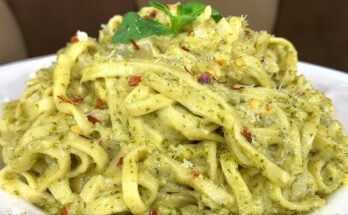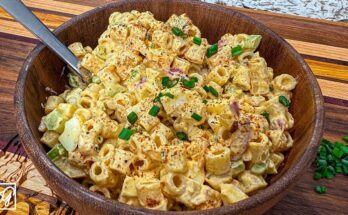Egg Custard Pie Recipe: Egg custard pie is one of those old-fashioned, comforting desserts that never goes out of style. It’s silky, creamy, and sweet, with a rich eggy base nestled inside a buttery, flaky pie crust. Whether you’re serving it for a Sunday dinner, bringing it to a potluck, or simply enjoying a slice with a hot cup of coffee, this dessert is a timeless classic.
What is Egg Custard Pie?
At its core, egg custard pie is made from basic ingredients you likely already have in your kitchen: milk, sugar, eggs, and a touch of vanilla. These simple items come together to form a velvety custard filling, which is poured into a pie crust and baked until just set. The result? A luscious, subtly sweet dessert that melts in your mouth. The top may develop a light golden hue, sometimes dusted with a sprinkle of nutmeg for added aroma and depth.
A Brief History of Egg Custard Pie
The roots of custard go back to the Middle Ages in Europe, where it was a popular filling for tarts and pastries. Egg custard pie, specifically, became a staple in Southern American kitchens, passed down through generations. It was especially beloved for its affordability—perfect for families looking to make something satisfying from pantry staples. Even today, it holds a special place in Southern comfort food culture, celebrated for its simplicity and homemade charm.
Ingredients You’ll Need
Before you get started, let’s talk about what you’ll need to make this delicious pie. The good news? You probably already have most of these ingredients in your fridge or pantry.
For the Pie Crust
You have two choices here: make your own from scratch or buy a pre-made one. If you’re going for the homemade route (which I highly recommend for the best flavor), here’s what you’ll need:
- 1 ¼ cups all-purpose flour
- ½ cup unsalted butter (cold and cubed)
- ¼ tsp salt
- 3–4 tbsp ice water
You’ll combine the flour and salt, cut in the butter until it resembles coarse crumbs, and add water gradually until the dough comes together. Chill the dough before rolling it out.
Or, if time is short, grab a good-quality store-bought crust—no judgment!
For the Custard Filling
This is where the magic happens. These humble ingredients are the soul of your pie:
- 3 large eggs
- ½ cup granulated sugar
- 2 ½ cups whole milk (room temperature)
- 1 tsp pure vanilla extract
- Pinch of salt
- Optional: ground nutmeg for topping
Whole milk is ideal here—it gives that rich, creamy mouthfeel. You can also use half-and-half or a mix of cream and milk for an even richer custard.
Essential Tools and Equipment
Having the right tools will make the process smoother. Here’s what you’ll want on hand:
- Mixing bowls
- Whisk
- Rolling pin (if making crust from scratch)
- 9-inch pie dish
- Measuring cups and spoons
- Fine mesh sieve (optional, for a smoother custard)
- Oven thermometer (optional but helpful for accuracy)
With these ready, you’re all set to make a bakery-quality egg custard pie right at home.
Step-by-Step Instructions
Let’s get into the real action now. Making an egg custard pie isn’t hard, but it does require a little patience and attention to detail.
Step 1: Prepare the Pie Crust
If making your own crust:
- Combine flour and salt in a large bowl.
- Cut in the butter using a pastry cutter or your fingers until the mixture resembles pea-sized crumbs.
- Add ice water one tablespoon at a time, mixing until the dough holds together.
- Shape into a disk, wrap in plastic, and chill for at least 30 minutes.
- Roll out the chilled dough on a lightly floured surface and transfer to a 9-inch pie dish.
- Trim excess dough and crimp the edges.
- Prick the bottom with a fork and blind bake at 375°F (190°C) for 10-12 minutes to prevent sogginess.
If using a store-bought crust, simply place it in the pie dish and blind bake for the same amount of time.
Step 2: Make the Custard Filling
- In a mixing bowl, whisk together the eggs and sugar until well combined.
- Slowly whisk in the milk, vanilla extract, and a pinch of salt.
- For an ultra-smooth custard, strain the mixture through a fine sieve to remove any egg solids.
It’s important that the milk isn’t too cold when added, or it can cause the custard to bake unevenly.
Step 3: Assemble and Bake the Pie
Now that your crust is ready and your custard mixture is smooth and silky, it’s time to bring it all together. Here’s how to do it:
- Preheat your oven to 350°F (175°C).
- Carefully pour the custard mixture into your pre-baked pie crust. Do it slowly to avoid creating bubbles or splashes.
- Optional: Sprinkle a light dusting of ground nutmeg over the top. This adds a warm, classic flavor and gives the pie a traditional look.
- Place the pie dish on a baking sheet to catch any spills and make handling easier.
Bake Time: Bake for 45 to 55 minutes. Ovens vary, so start checking around the 40-minute mark.
How to Know It’s Done: The pie should be mostly set but still have a slight jiggle in the center—like Jell-O. Don’t overbake it! The custard will continue to firm up as it cools. A knife inserted near the center should come out clean or mostly clean.
Pro Tip: If the crust edges are browning too fast, cover them with foil or a pie shield halfway through baking.
Step 4: Cooling and Serving Tips
After baking, remove the pie from the oven and place it on a wire rack. Allow it to cool completely at room temperature—this is crucial. If you slice into it too soon, the custard won’t have time to fully set.
Once cooled, you can refrigerate the pie for at least 2 hours before serving. Chilling helps enhance the flavor and texture.
Serving Suggestions:
- Serve as-is for a classic touch.
- Add a dollop of whipped cream or a scoop of vanilla ice cream for a modern twist.
- Garnish with fresh berries for a pop of color and tang.
Whether served warm, room temperature, or chilled, egg custard pie is always a crowd-pleaser.
Tips for the Perfect Egg Custard Pie
Even though this recipe is simple, a few key tips can make a big difference in the final result. Here’s how to ensure your pie turns out flawlessly every time.
Avoiding Common Mistakes
- Overbaking: This is the #1 mistake. Overbaked custard turns grainy and rubbery instead of silky smooth. Keep an eye on it and remove from the oven while there’s still a slight jiggle.
- Using cold milk: Always use room temperature or slightly warm milk when mixing your custard. Cold milk can shock the eggs and result in uneven baking.
- Not blind baking the crust: If you skip this step, you risk ending up with a soggy bottom. A quick pre-bake keeps your crust flaky and firm.
- Not straining the custard: Straining removes chalaza (the white stringy part of the egg) and ensures a smooth texture.
Enhancing Flavor and Texture
- Vanilla extract: Don’t skimp on quality here. Use real vanilla extract (or even a vanilla bean if you’re feeling fancy) for the best taste.
- Nutmeg: Just a pinch goes a long way. Freshly grated is best.
- Dairy choices: Whole milk is standard, but for extra creaminess, try replacing 1 cup of milk with half-and-half or heavy cream.
These simple tweaks elevate a humble pie into something truly special.
Variations and Customizations
While the classic egg custard pie is beloved for its simplicity, you can absolutely put your own spin on it. Here are some creative and delicious ways to personalize your pie while keeping its creamy, nostalgic charm intact.
Dairy-Free or Low-Sugar Alternatives
If you’re catering to dietary needs, it’s surprisingly easy to adapt this recipe:
Dairy-Free Version:
- Substitute whole milk with unsweetened almond milk, oat milk, or coconut milk. Keep in mind that these alternatives may subtly change the flavor and texture.
- Use a dairy-free pie crust or make your own with plant-based butter or shortening.
Low-Sugar or Keto Version:
- Replace granulated sugar with erythritol, monk fruit sweetener, or stevia (be sure to use a blend designed for baking).
- Opt for a low-carb or almond flour pie crust.
- Use unsweetened almond milk or heavy cream for fewer carbs.
These swaps make the pie suitable for people with lactose intolerance, diabetes, or those on a keto or low-carb diet—without sacrificing taste.
Adding Spices or Toppings
You can take your egg custard pie to the next level with these fun add-ins and toppings:
Spices to Try:
- Cinnamon: Add a pinch to the custard mixture for a cozy flavor.
- Cardamom: A small amount adds an exotic twist.
- Allspice or clove: For a deeper, warmer flavor profile.
Toppings & Extras:
- Caramel drizzle: Adds richness and sweetness.
- Fresh berries: Offer a fresh contrast to the creamy filling.
- Toasted coconut: Adds crunch and tropical flavor.
- Citrus zest: Lemon or orange zest adds brightness to the custard.
With just a few tweaks, your pie can go from traditional to gourmet in minutes.
Storing and Reheating Egg Custard Pie
So, you’ve made your masterpiece—now how do you store it?
Refrigeration:
- Egg custard pie must be refrigerated due to its dairy and egg content.
- Cover the pie loosely with plastic wrap or foil and store in the fridge for up to 4 days.
- It actually tastes even better after a day as the flavors meld.
Freezing:
- You can freeze it, but know that the texture may change slightly upon thawing.
- Wrap the pie tightly in plastic wrap and then foil. Freeze for up to 2 months.
- To thaw, place in the refrigerator overnight—don’t microwave directly from frozen.
Reheating:
- For a warm slice, heat in a 300°F oven for 10–15 minutes.
- Avoid microwaving as it can cause uneven heating or rubbery custard.
Whether fresh or reheated, egg custard pie maintains its comforting appeal.
FAQs about Egg Custard Pie Recipe
Can I use store-bought pie crust?
Absolutely. A good quality store-bought crust works fine and saves time. Just remember to blind bake it first to prevent sogginess.
Why did my custard curdle?
Overbaking or using very cold milk can cause the eggs to scramble. Bake just until the custard is set with a slight jiggle in the center, and use room-temperature milk for mixing.
How do I know when the pie is done?
Gently shake the pie—if the center jiggles slightly but the edges are set, it’s done. A knife inserted near the center should come out clean or with just a bit of custard clinging to it.
Can I freeze egg custard pie?
Yes, though the texture might change slightly. Wrap it well and freeze for up to 2 months. Thaw overnight in the fridge before serving.
What’s the best milk to use?
Whole milk is ideal for its balance of creaminess and flavor. You can substitute with half-and-half or a mix of cream and milk for a richer pie.
Final Thoughts
There’s something so satisfying about making an egg custard pie from scratch. It’s a simple, honest dessert that’s stood the test of time—creamy, comforting, and endlessly adaptable. Whether you stick with the traditional recipe or add your own flair, you’re sure to end up with a pie that’s not just delicious, but memorable.
Try it once, and you might just find it becoming a regular in your dessert rotation. Homemade, from-scratch pies have a way of warming hearts—and bellies. So grab your ingredients, preheat that oven, and get baking!



